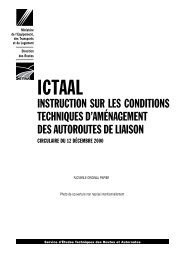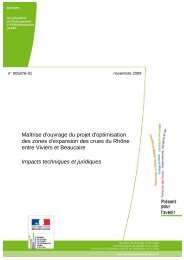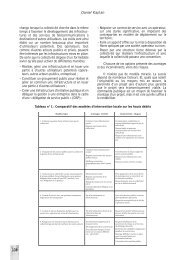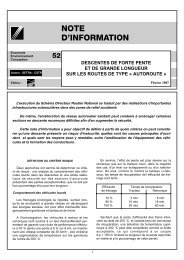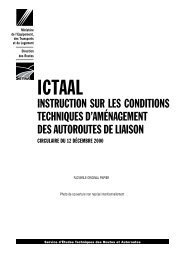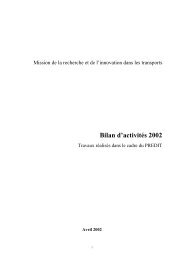des tic et des territoires - Portail documentaire du ministère de l ...
des tic et des territoires - Portail documentaire du ministère de l ...
des tic et des territoires - Portail documentaire du ministère de l ...
Create successful ePaper yourself
Turn your PDF publications into a flip-book with our unique Google optimized e-Paper software.
84<br />
Some authors are <strong>de</strong>veloping the i<strong>de</strong>a of the<br />
<strong>de</strong>velopment of a “plural soci<strong>et</strong>y”, a soci<strong>et</strong>y with<br />
many levels, and the emergence of “plural activity”.<br />
“Plural activity” means the recognition of a diversity<br />
of activities, a plural economy and a plurality of<br />
social times in which the indivi<strong>du</strong>als can find their<br />
social i<strong>de</strong>ntity and their incomes. The i<strong>de</strong>a of a soci<strong>et</strong>y<br />
of plural activity is in opposition to the mo<strong>de</strong>l of<br />
a soci<strong>et</strong>y compl<strong>et</strong>ely organised around the salaried<br />
work. [Gaullier, 1997].<br />
In this category of literature, the future of work<br />
and soci<strong>et</strong>y is envisaged trough radical changes.<br />
Other corpuses of literature consi<strong>de</strong>r the future of<br />
work, also in a perspective of integration and cohesion,<br />
but in fewer fundamental and more prac<strong>tic</strong>al<br />
ways. Some scenarios consi<strong>de</strong>r new fields of activities,<br />
new status conditions or new global conceptions<br />
of full employment in or<strong>de</strong>r to favour the integration<br />
of unemployed people. Their approaches<br />
try to intro<strong>du</strong>ce security in the peripheral labour<br />
mark<strong>et</strong>s and in the multiple passing from core<br />
labour mark<strong>et</strong> to peripheral labour mark<strong>et</strong>s <strong>du</strong>ring<br />
someone’s life.<br />
This is the key i<strong>de</strong>a <strong>de</strong>veloped by Schmid<br />
[1998] in the concept of transitional labour mark<strong>et</strong>,<br />
for example. The concept consi<strong>de</strong>rs employment<br />
and professional carrier from the perspective of a<br />
whole working time along someone’s life. It also<br />
consi<strong>de</strong>r atypical ways of working as socially useful<br />
labour mark<strong>et</strong>s. But these mark<strong>et</strong>s need to be regulated<br />
and not regar<strong>de</strong>d as ways leading to precariousness.<br />
This way of <strong>de</strong>aling with the question of<br />
employment and unemployment consi<strong>de</strong>rs the socalled<br />
“atypical labour mark<strong>et</strong>s” from a radically different<br />
angle.<br />
Telework is often regar<strong>de</strong>d as a mean for integration<br />
and social cohesion. A great number of telework<br />
experiments have been, and are still, <strong>de</strong>veloped<br />
in or<strong>de</strong>r to fight exclusion and unemployment.<br />
These new theories of flexible labour mark<strong>et</strong><br />
can help to <strong>de</strong>velop such “socially oriented” telework<br />
experiments.<br />
Flexible Labour Mark<strong>et</strong>s oriented towards<br />
Indivi<strong>du</strong>alism<br />
Besi<strong>de</strong> the scenarios of the future of work<br />
turned towards social integration, other visions are<br />
quite more indivi<strong>du</strong>alis<strong>tic</strong> and consi<strong>de</strong>r the future<br />
of work through self-employment and self-management.<br />
Flexibility becomes a general attribute of all<br />
the work prac<strong>tic</strong>es and how to gain some security is<br />
left to indivi<strong>du</strong>als.<br />
For some authors the worker of the future will<br />
be a self-employed, poly-active man or woman,<br />
managing his or her own carrier in an indivi<strong>du</strong>alis<strong>tic</strong><br />
world. Tomorrow’s worker must be able to man-<br />
Patricia Vendramin<br />
age the “enterprise of himself” [Bühler &<br />
Ettighoffer, 1995] in an autonomous and responsible<br />
way. From this viewpoint, the worker is preferably<br />
self-employed. One goes from a logic of<br />
employment to a logic of a supply of services, with<br />
a “poly-active man” as the new worker’s profile. This<br />
strategy suits companies, which prefer to buy the<br />
skills they need, when they need them, where they<br />
are to be found, rather than to pay to have them<br />
constantly at their disposal. In these views, the<br />
worker becomes his or her own manager.<br />
It can be asked, however, wh<strong>et</strong>her for the<br />
majority of workers, the self-management or polyactivity<br />
era is not very close to a catch-as-catch-can<br />
economy. The reality shows that many selfemployed<br />
workers did not really choose this status –<br />
they were more or less forced into it by reorganisation<br />
in their companies (through downsizing, outsourcing)<br />
[Cornford & al., 1996].<br />
In the literature about telework, self-employment<br />
is also often envisaged and the workers are<br />
supposed to become “free-lancers”. The term “contingency<br />
workforce” is also used. In the United<br />
States the “contingency workforce” has become a<br />
wi<strong>de</strong>ly used term. The contingency workers are<br />
those belonging to the growing number of “employees”<br />
working on one-year or six-month contracts,<br />
often half time, and with several jobs at the same<br />
time. From the company’s perspective this way of<br />
working represents a “just-in-time” thinking,<br />
applied on its staff. Obviously, for the employee the<br />
more loose relation to the labour mark<strong>et</strong> often represents<br />
insecurity and uncertainty, but also the<br />
opportunity for flexibility and constantly new challenges<br />
as well as the great freedom so highly valued<br />
by the generation born in the seventies [Forsebäck,<br />
1995].<br />
If we find a great number of telework experiments<br />
oriented towards social integration, a lot of<br />
discourses about telework also belong to the indivi<strong>du</strong>alis<strong>tic</strong><br />
approach and put all professional profiles<br />
on the same footing, as if the potential and constraints<br />
of a system engineer were the same as those<br />
of a secr<strong>et</strong>ary or a nurse.<br />
Current Trends in the Development<br />
of Telework<br />
The concept of telework is born in the economic<br />
and technological context of the early eighties.<br />
At this time, the dominant trends <strong><strong>de</strong>s</strong>cribed<br />
above were not y<strong>et</strong> prevalent as such. The current<br />
reality of telework covers both old forms of telework<br />
inherited from the past and new forms of telework<br />
emerging from the context of the late nin<strong>et</strong>ies.



